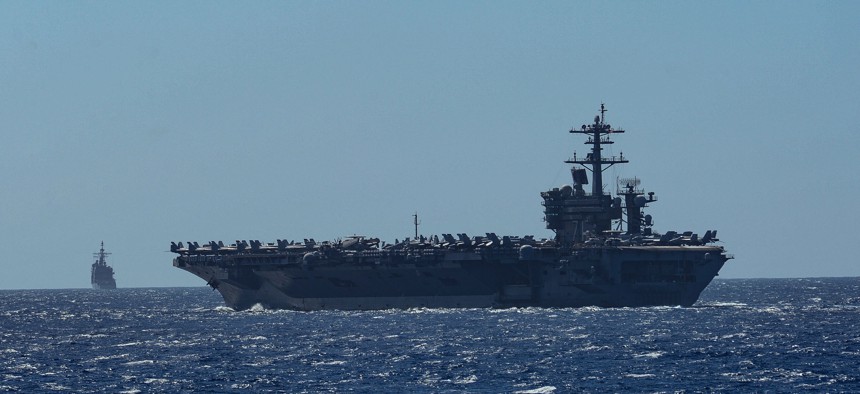
The aircraft carrier USS Theodore Roosevelt (CVN 71) and the Ticonderoga-class guided-missile cruiser USS Bunker Hill (CG 52) transit the Philippine Sea Feb. 29, 2020. U.S. Navy / Mass Communication Specialist 3rd Class Sean Lynch
US Navy Evacuating Aircraft Carrier Infected by Coronavirus
A skeleton crew will man critical stations while Theodore Roosevelt is disinfected pierside in Guam, Acting Secretary Modly said.
Updated, 7:40 p.m.
The U.S. Navy says it will remove the majority of USS Theodore Roosevelt's crew so the aircraft carrier can be disinfected, one day after its commanding officer sent an urgent message asking for help controlling a COVID-19 outbreak.
“The key is to make sure that we can get a set of crew members that can man all those critical functions on the ship, make sure they’re clean, then get them back on while we clean the ship and get the other crew members off," Acting Navy Secretary Thomas Modly said in a Tuesday interview with CNN. “And that’s the process we’re going through. It’s very methodical. We’re absolutely accelerating it as we go.”
The 1,100-foot Theodore Roosevelt tied up in Guam on Friday after several sailors were discovered to be infected. On Monday, Capt. Brett Crozier sent an extraordinary four-page letter asking for Navy help. His warship has no space to give infected patients a separate berthing space and bathroom, so he asked for assistance finding rooms ashore.
"The spread of the disease is ongoing and accelerating,” Crozier wrote in the March 30 letter, which was obtained by the San Francisco Chronicle. "Decisive action is required.”
Crozier recommended isolating or quarantining more than 4,000 sailors for two weeks to ensure that no one carries the virus back aboard. Meanwhile, about 10% of the crew would be needed to run the ship in port and disinfect it, he wrote.
“Keeping over 4,000 young men and women on board the TR is an unnecessary risk and breaks faith with those Sailors entrusted to our care,” the captain wrote.
Related: US Navy Working to Keep Subs and Destroyers From Becoming COVID-19 Hotspots
Related: The US Navy Can, and Should, Do More Against the Coronavirus
Related: The Prognosis: Latest News on Coronavirus & National Security
In the interview, Modly said, "We've been working the past several days to get those sailors off the ship and to get them into accommodations in Guam. The problem is that Guam doesn't have enough beds right now, so we're having to talk to the government there to see if we can get some hotel space, or create some tent-type facilities there."
In a conference call with reporters early on Tuesday evening, Pacific Fleet commander Adm. John Aquilino said, “We understand the [CO’s] request. We’ve been working it in advance, continue to work it and I’m optimistic that the additional quarantine and isolation capacity that’s being discussed will be delivered shortly."
Aquilino underscored that some portion of the crew would remain aboard.
"I need to be able to run the [nuclear] reactors, fight fires, do damage control, feed the crew that’s aboard. All of those things are a requirement and the team is working through how to do that while at the same time executing our approach to generating fully healthy and COVID-free sailors," he said.
Aquilino declined to say how many Roosevelt sailors are infected. But he said, “I have no sailors hospitalized. I have no sailors on ventilators. I have no sailors in critical condition. No sailors in an ICU status on the Theodore Roosevelt."
Modly said that testing aboard the Roosevelt was initially limited to about 200 sailors per day. He said that will soon be increased by sending tests elsewhere for processing.
A tougher environment to disinfect can scarcely be imagined. A Nimitz-class carrier has more than 3,000 spaces — “rooms,” to non-sailors — that hold all manner of complicated and dangerous machinery, up to and including nuclear reactors.
In his letter, Crozier wrote that the carrier could still go into battle and win, because “in combat we are willing to take certain risks that are not acceptable in peacetime. However, we are not at war, and therefore cannot allow a single Sailor to perish as a result of this pandemic unnecessarily.”
Asked by CNN how the Navy balances keeping sailors safe while keeping America safe, Modly said, "It is a balancing act, and we're working to make that balance acceptable."
The Roosevelt and its associated battle group departed San Diego on Jan. 17 and was amid a deployment to the western Pacific when its first crew member was found to have COVID-19. Aquilino declined to discuss the ship’s future operational schedule.
Marcus Weisgerber contributed to this report.




